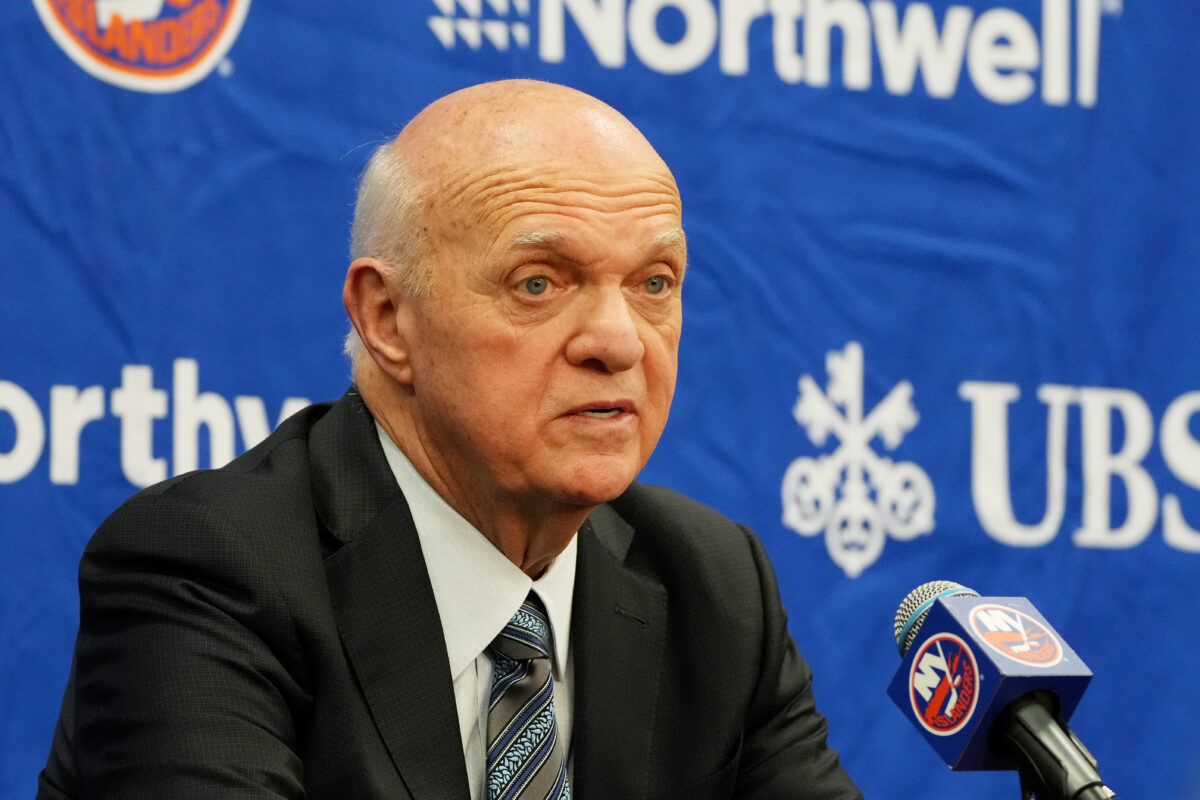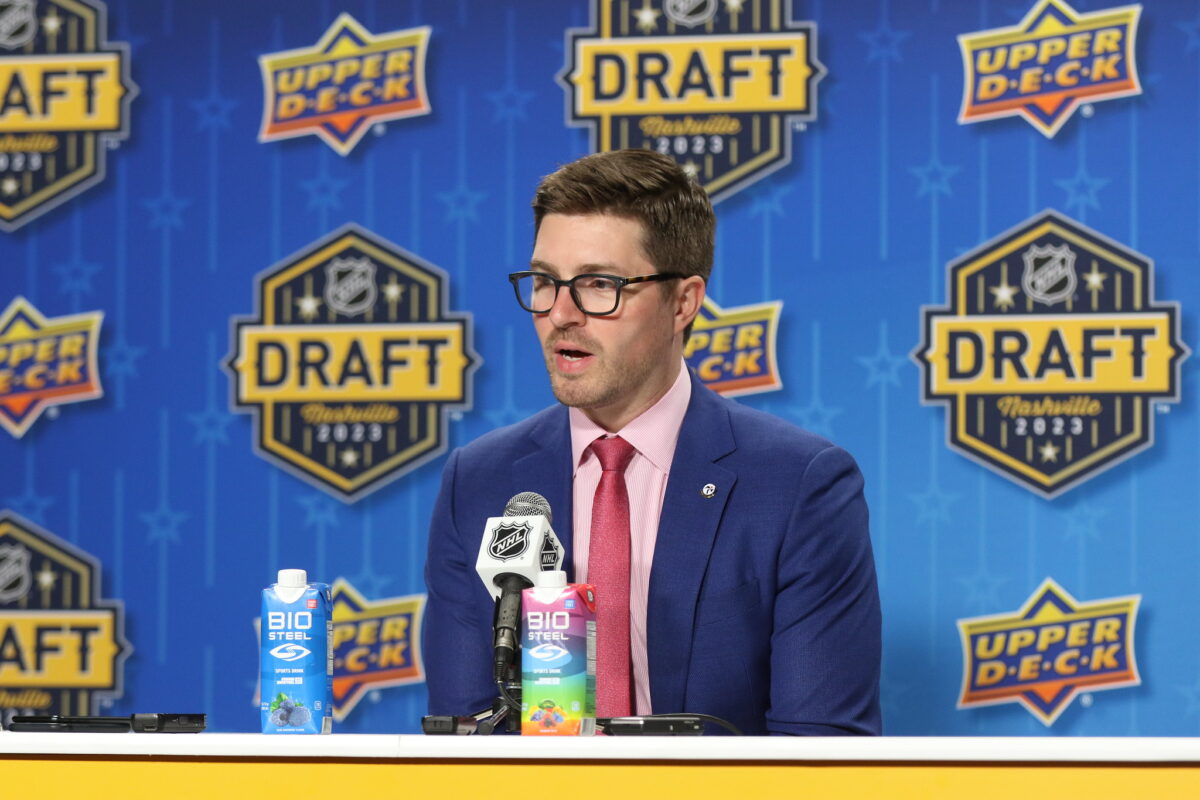It’s one of the biggest “what ifs” in recent Toronto Maple Leafs history: what if Lou Lamoriello had remained as general manager (GM) instead of Brendan Shanahan handing the job to Kyle Dubas in 2018? The decision marked a turning point in the franchise’s trajectory.
Related: Ex-Maple Leafs’ GM Dubas: Symbol of Hockey’s Generation Gap
Now, looking back, it’s fair to ask whether things might have turned out differently had the three-time Stanley Cup winner stayed in charge.
Lamoriello Was Shanahan’s Mentor, Then He Was Replaced
When Lou Lamoriello arrived in Toronto in 2015, the understanding was that he’d serve as a short-term mentor to Brendan Shanahan, who was still learning the ropes as team president. Lamoriello was already one of the most respected executives in NHL history — a no-nonsense leader who had built championship rosters with the New Jersey Devils.
But after three seasons, Shanahan decided it was time for a change. Lamoriello, still energetic and not ready to retire, was replaced by his much younger assistant, Kyle Dubas.
Related: Maple Leafs’ Victor Johansson Has Made Himself a Top Defensive Prospect
Dubas, then just 32 years old, was seen as a progressive, forward-thinking “yes-man” to Shanahan’s vision. He brought youth, smarts, and optimism to his new job. He also surrounded himself with solid young thinkers who brought a modern analytics approach. That said, did his inexperience in managing a star-studded roster come back to haunt him and the Maple Leafs?
Would Lamoriello Have Handled the Core Four Differently?
One of the stark contrasts between the two GMs lies in contract negotiations. Under Dubas, the Maple Leafs’ young stars — William Nylander, Auston Matthews, and Mitch Marner — each signed big-money extensions with heavy signing bonuses, no-movement clauses, and top-of-the-market salaries. Critics argue the players and their agents “walked all over” the front office.

Although looking back, one can find anomalies, Lamoriello had a reputation for being unflinching at the negotiating table. It’s hard to imagine him giving up term, cap space, and trade flexibility so freely. He might have played hardball, delaying extensions or pushing for more team-friendly deals. At the very least, it’s doubtful all three contracts would have been so player-friendly.
The Tavares Question
Dubas’ most celebrated move as Maple Leafs general manager was signing John Tavares in the summer of 2018. But in reality, Toronto was always the heavy favorite. The San Jose Sharks were the only other serious contender, and Tavares had long wanted to play for his hometown team.
Given that leverage, why pay the full $11 million per year? A more seasoned GM like Lamoriello might have shaved even a million dollars or two off the deal, freeing up valuable cap space down the line.
Related: 3 Maple Leafs Storylines to Follow in 2025-26
Tavares is still a productive player, but his $11 million contract consumed a large portion of the salary cap. As a result, this deal cannibalized the Maple Leafs’ roster flexibility for years.
Roster Construction: Identity Matters
Perhaps the most significant philosophical difference between the two general managers rested in roster building. Dubas leaned heavily on small, skilled forwards and an aging mix of veterans. His so-called DNA would have been utterly different from what Lamoriello’s would have been. While the Maple Leafs had talent in abundance, they often lacked a clear identity — the kind of character players and championship-hardened veterans that Lamoriello valued.
Earlier this week, Dubas admitted in an interview that his biggest regret as Maple Leafs GM was trading Mason Marchment for Denis Malgin. Malgin barely played in Toronto, while Marchment went on to create his career with the Florida Panthers. Interestingly, although Dubas pulled the trigger on that trade – and never threw anyone else under the bus for the decision – the conversation hinted he wasn’t entirely on his own in making that move. There was encouragement from elsewhere in the organization to grab some “skill.” The conversation suggests that Dubas did not have complete control over every decision, which is how management should work.
Lamoriello’s Post-Toronto Record Was Less Impressive, Yet …
Lamoriello’s post-Toronto record speaks for itself: within a few seasons of taking over the New York Islanders, he had built a team that reached back-to-back conference finals. That wasn’t an accident. His formula — disciplined defense, strong goaltending, and physically engaged forwards — works in the postseason. The Maple Leafs, under Dubas, have never fully adopted that approach, and the results are what they are.
Related: Ex-Maple Leafs Kasperi Kapanen: Where Is He Now?
On paper, the Maple Leafs have posted better regular-season and postseason records than the Islanders, but results alone don’t tell the whole story. Dubas had more talent to work with in Toronto, while Lamoriello built a harder, more disciplined Islanders team that punched above its weight class. That contrast makes it tough to judge what Lamoriello might have achieved had he stayed in Toronto. Still, it’s fair to wonder if his no-nonsense approach could have pushed the team further when it mattered most.
Why Lamoriello Didn’t Stay in Toronto
When Dubas was promoted, Lamoriello was reportedly offered an advisory role but declined to accept it. Whether he wasn’t interested or didn’t want to work alongside the inexperienced Dubas is unclear. Some speculate he saw early signs of stubborn thinking and decided it would be an exercise in futility. Instead, he left for the Islanders, where he immediately restored organizational discipline and respect.

Dubas has always considered Lamoriello a mentor — and still does to this day, it seems. Of course, it’s probably easier for him to say that since he’s the one who ultimately landed the job. There’s a certain magnanimity in speaking that way when you hold the upper hand. Still, while fans may not agree with all of Dubas’ choices, there’s nothing in his past to suggest he was a bad guy. He was transparent, made the best decisions from his perspective, and surrounded himself with modern tools and intelligent people to help build the team.
The Final “What If” for Lamoriello and Dubas
Now with the Pittsburgh Penguins, Dubas faces a different challenge. His main task is to maximize the final years of Sidney Crosby’s era. He convinced Fenway Sports Group to buy into his vision, but the Penguins’ aging core and shallow prospect pool make it a risky long-term situation. If Mario Lemieux returns to an ownership role, Dubas might find himself under far closer scrutiny.
Related: What’s Really Holding the Toronto Maple Leafs Back?
We’ll never know exactly how things would have unfolded if Lamoriello had stayed in Toronto. However, it’s reasonable to think that the Maple Leafs’ salary cap situation would be healthier, their roster would be more playoff-ready, and their organizational discipline would be stronger. Shanahan’s decision to move on from Lou and fast-track Dubas remains one of the most consequential choices in modern Maple Leafs history — and one fans will debate for years to come.
